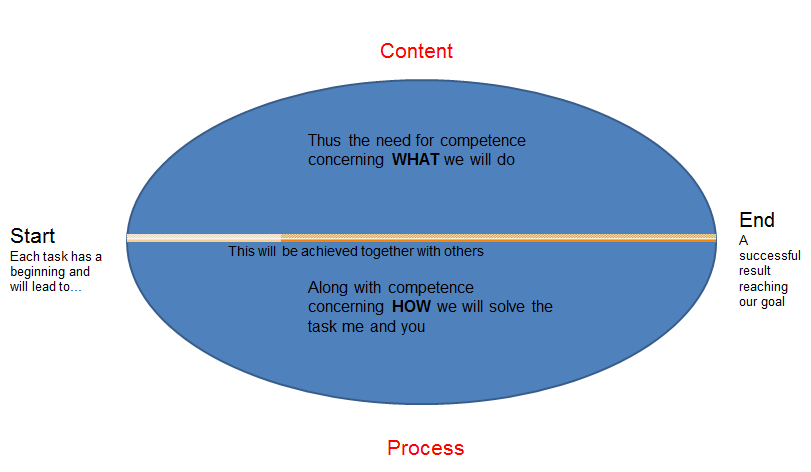As usual I will start with some more reflection questions. I assume that You have read the previous blog about Human Relations and communication so now its time to reflect. You can share your reflections in the comment section below or keep them with your personal use. But do spend time on reflections. The Questions are:
- What behaviors Help/Hinder the group to maximize the learning?
- What did I hold back from doing/What stopped me?
- What Can I do to get more out of the team building for others/for myself?
- How Can I apply what I learned in other situations?
You can also try to reflect on the questions in the previous post. Once again this is the most important part of Facilitation and I want you to spend some alone time with these questions and really reflect.
Content and Process Model
Today I will discuss the difference between content and process. Every project is divided into these 2 parts. Most of us neglect the Process part and just focus on the Content. Being Facilitator you need to focus more on the Process. Let me explain these visually.
Every project has a start, middle and an end. Content and Process are the middle parts. Content is WHAT the project is all about and Process is HOW to do the project. It includes group dynamics, team building, leadership, communication, feedback, reflection and much more.
I will discuss about pros and cons, things you need to follow and remember and some tips. It will all be explained in very simple sentences. At the end you will be able to understand the basics of Content and Process Model.
Content and process Model is about goals (start), tasks (Content/WHAT), processes (Process/HOW) and results (End). Every work has a number of aspects to consider. These aspects are:
- What is the goal, what is to be achieved?
- Which assignments or tasks do we need to complete in order to reach the goal?
- Which work processes or models will help achieve the goal?
- Who are ’we’ that shall reach the goal?
- How can we measure the end result? How do we know we have achieved the goal? How will we evaluate?
It is all about planning, planning and planning. I will be going over on the tasks for each part of this model in the later posts. For now just stay with me and digest these tips and points. What I can do now is to separately explain in the parts of this model.
Goal (start)
- Sets the direction and end point of what the group and/or individual strive to achieve.
- Creates a motivating tension between the individuals and their work.
- Creates mutual understanding among all in the group members to achieve the same result.
Make clear goals 🙂
Groups that take the time to talk about goals and create mutual understanding will most likely not have to spend time later on getting everybody back on the same track.
Assignments and tasks (content/WHAT)
- Are what you or the group do to achieve the goal.
- Both should lead towards the goal
This area can further divide into two parts:
- Resources the group have
time, money, competences, who will do etc.
- Actual process looks like
(covered in the next section)
Work Processes and Work Models (process/HOW)
- They deal with the organisation we create to accomplish assignments and tasks in order to reach the goal.
It is within this process of organizing things we will create the stage where we will meet each other and cooperate, or not. This is called Process. Cooperate means:
- It covers how we communicate
- Make decisions
- Deals with conflicts
- Give each other feedback etc…
This is basically all I have to share today. Next there are some tips that you may want to look at. We saw the word “we” earlier on, let me explain what does it means.
We
- Who we are is about ’you and me’, about what we bring to the group.
- It is both about our resources and the different sides of us that may impact how we work together.
for example: May be it is hard for me to take feedback, project discontent about others or the conditions within the organisation.
Another important question that you may ask is How could you know that the goal has achieved or the job is done. I have some points which you may consider looking.
- When ever the goal is analysed the evaluation should be considered as well and when ever the goal is reviewed the method of evaluation must be reviewed too.
- The result is the outcome of the group’s performance. The result can be in line with the goal or not. This is why it is important to think about evaluation upfront and to conduct it during the process or afterwards.
Evaluation
It is the part of the start. So along with the goal you should also make an evaluation. Evaluation can be formative i.e. It takes place during process and can help steer the work process back on track if it has lost its focus on the end goal. In simple words keep an eye on the end goal and evaluation through out the whole process.
The End.
I just want to give you additional resources: a video and a link to an article on process and content.
Simon Sinek: How great leaders inspire action
Link to an Article
Atherton J S (2013) Doceo; Content and Process [On-line: UK] retrieved 12 February 2014 from http://www.doceo.co.uk/tools/process_content.htm
Please feel free to add comments and have discussions with me. Subscribe to get the posts regularly and never have to miss any. See you in the next post…
Imran

